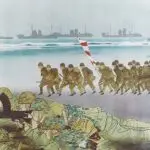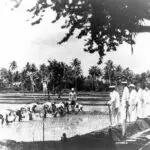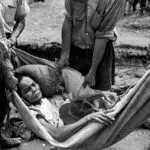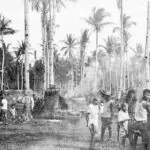WWII: Oral War Histories of the CHamoru/Chamorro People
Table of Contents
Share This
Guam is attacked
In the early morning of 8 December 1941, Japanese war planes flew to Guam from Saipan and bombed the island. In Sumai, the Standard Oil tanks caught fire from strafing and bombing. The Marine Barracks, the Cable Station and the Pan American facilities, also in Sumai, and the Navy landing docks in Piti suffered damage. The USS Penguin came under heavy attack and sank off Orote Point after being scuttled by the crew. While a few crew were injured they all made it ashore in rafts. Later on, the skipper died at the hospital.
They bombed again the next day and then invaded the island by shore on 10 December. The small US military contingent on Guam surrendered and the Japanese quickly took over the island. All of the Americans and some Spanish priests, nearly 600 people, were taken prisoner and sent to camps in Japan.
After the initial excitement and confusion, many people packed up their belongings and moved to their lanchos (ranches) away from Sumai and Hagåtña, the two most populated villages of Guam. The physical damage to Hagåtña wasn’t bad but damage to its way of life was irreparable. The wartime exodus shattered the life of the city. Hagåtña was never to be the same again. It also marked the end of Sumai village.
Before long the Japanese put everyone to work, clearing, planting and doing various tasks as assigned. Some children went to school for a few hours a day, but day in and day out, everyone worked.
The Japanese occupation of Guam lasted almost three years. People who survived the war often recall how difficult life was then, including being forced to work without pay, suffering from hunger, fearing rapes, beatings and massacres at the hands of the Japanese, and marching to concentration camps. People also remember acts of kindness and good times.
Here are some of Guam’s war survivors stories:
Forced labor
Art Toves, born and raised in Sumai, said his father was at work at the Cable Station when Guam was first bombed. His mother gathered the family up and they ran to Hågat, taking anything they could carry. Toves recalled that they waited under some mango trees for his father to get off work and join them. They stayed with an uncle until they were told that all able-bodied people must report to work. Toves was assigned to help build the Orote Point airstrip.
Barbara Dela Cruz was ordered to work at Tai, Chalan Pago and Kalaguag, Tiyan pulling weeds and gathering wood. She worked all day, walking to and from her house in Sinajana. She was not paid or given food to eat.
Elvina Reyes Rios was living in Hågat during the war. She was 13 years old when the war began. She was made to work in the rice fields in Piti and also in the Hågat gardens. Later she was assigned to work in Kalaguag clearing land. She stopped to stretch once, she remembered, and the Japanese guard threw rocks at her, scarring her back. Later still, she was assigned to work at Fena, being roused from sleep at 2 am by her mother. She had to walk by herself in the dark from Nimitz Beach to Fena to arrive by 6 am. If she was even one minute late she would be slapped. Three minutes late, three slaps. After working in the fields all day Rios was told to grate 125 coconuts and then walk home, arriving there at 9 pm.
After children worked in the fields all day some had to go to Japanese school at night. They were not paid or fed. They were beaten if they worked too slowly, and beaten more if they had light skin or looked “American” in any way.
Joseph Torres Barcinas of Malesso said Japanese soldiers built a warehouse-like hut and summoned the villagers to work there. He said they’d bang a piece of metal on a barrel at about 5:30 am to call everyone to work. If they didn’t show up they’d be killed. He was nine years old at the time.
Some of the elderly people were just harassed, even some of the young ones.
They were tied to a coconut tree and the Japanese would come by and swing a sword at them.
Juan Martinez Unpingco was sent to Mangilao to dig soil all day to find and collect manganese and turn the material over to a Japanese soldier. He said they seldom went anywhere except to work, partly because they were scared to meet up with Japanese soldiers along the way. He saw them slap people and even stab people to death with their bayonets. The soldiers came to his family’s ranch once and destroyed their things and terrorized them. One of them raped his aunt.
Vicente Taisipic of Yona said people were rounded up and taken to a compound near the school to be indoctrinated by the Japanese. Every 15 minutes they were made to face north toward Japan and bow. Deprived of his childhood, at six years old he was given two jobs. One job was to pull the teacher’s son around the compound in a wagon for half an hour first thing in the morning. After that, it was classes until noon. Then the children planted and harvested fruits and vegetables.
Taisipic’s other job was to collect manure around Yona—human or animal. If he did not fill six buckets with manure he was beaten. At the end of the day he walked back to his family ranch to take care of the animals and bathe in the river with no soap. He felt like a living maggot.
He recalled seeing a man beaten many times because he looked American, and that his own family had to give up their carabao because the Japanese wanted to slaughter it for a wedding party.
Ben Blaz, too, recalled abuse at the hands of the Japanese. He said though CHamorus/Chamorros thought the idea of bowing to show respect was absurd, they had to do it, and do it just right.
A poorly done bow to one soldier might earn nothing more than a well placed boot or a few slaps, while another might resort to stomping or hitting you time and again until your face was swollen.
There was no telling so people just did their best. There was also no end to people and places to bow to – police stations, military installations and government offices.
From the outset, Blaz recalled, CHamorus saw bowing as a means to humiliate them, to make them demonstrate their perceived inferiority. For that reason, he and others turned the bows into insults. As they stiffly bent at the waist they would cheerily declare in CHamoru:
Good morning, Asshole!
Or, Blaz’s favorite:
Now that I’m bending over, kiss my ass!
They were careful to only be polite when the Saipanese interpreters were around though.
Rosa Roberto Carter had to clear fields in Mangilao, along with her brother Juan. Once she was singled out by Japanese soldiers and locked up in a tiny room at a school house where she was interrogated about her loyalty to the United States. Carter thinks it may have to do with her slightly lighter skin color. She said the experience was terrifying and remained vivid in her mind for the rest of her life. After the interrogation she was given the extra duty of carrying lunches to Japanese soldiers in Tai.
Teresa Borja said the Japanese insisted even her crippled mother had to work. Borja was 12 years old at the time, and remembered her brother being beaten and killed by the Japanese. She was tied to a tree by Japanese soldiers once and left there all day, like a cow or carabao.
Joe Crisostomo Aguon and his family moved from their Hagåtña home to their Barrigada ranch after the Japanese took over Guam. He recalled obtaining a pass which allowed CHamorus to travel anywhere on the island. Anyone walking around without a pass would be in trouble with the Japanese police. Aguon and his brothers and sisters attended Japanese school where he recalled being slapped and kicked by his teacher for not bowing properly to the Emperor of Japan.
In late 1942 Aguon was forced to work at Tiyan, digging and bringing water to the Japanese soldiers. At the end of the day, he and the other assigned workers got a handful of rice as payment. Later in the year, Aguon was assigned to work in Kañada, Barrigada as a mess boy and later, he was transferred to work in Ordot digging tunnels. If the Japanese were not satisfied with the laborers’ work they were told to line up face-to-face and slap one another. When Aguon’s turn came, he refused to slap the old man facing him and he was hit by the Japanese guard with a stick. The old man whispered:
Go ahead and slap me, I will understand.
By the spring of 1944 all able-bodied men were forced into labor battalions. For the most part they worked without any compensation. In addition to building airfields at Orote and Kalaguag-Tiyan, CHamorus dug hundreds of air raid shelters and caves along the cliffs and hillsides which the Japanese used for shelter and storage. They paved roads, built pillboxes, gun emplacements and underwater obstacles in various parts of the island.
The workers only had wheelbarrows, picks, shovels and other hand tools.It was back breaking work under the sun all day. The working conditions were made worse by constant harassment and physical punishment. The men were often kicked, slapped, punched and clubbed.
Massacres
In the months leading up to the American retaking of the island in July 1944, after two and a half years of forced labor and much abuse, everything got worse. Tensions among the Japanese were high and CHamorus paid the price. Social activities were terminated, schools were closed, and CHamoru men, women, and children over the age of 12 were forced to work even longer hours in the fields, repair or build airstrips and defense installations, and dig hundreds of Japanese cave shelters. CHamorus, laboring at bayonet point, were mistreated and, in some cases, executed after completing defense installations.
Barbara Dela Cruz witnessed the beheading of three CHamoru men who the Japanese accused of spying and for assisting the one American holdout, George Tweed. During the execution, she was placed in the front row, a few feet away from the men who were to be killed. It was a painful experience because the Japanese threatened that anyone who looked away or showed any emotion during the execution would be next, saying they were witnessing what could be done to them as well.
Art Toves of Hågat said he was made to dig holes and trenches at Fena. One afternoon, he was told to go to the cemetery and dig a hole for two. He did so and then hid under some banana trees. Before long a Japanese soldier came with two local men and their mother. The three followed behind a car and two Japanese, armed with swords and pistols, walked behind them. They were ordered to kneel and face one another. One man was beheaded and the other shot. Toves said the worst thing was that the mother of the young men was forced to watch, as was he. If he said anything he would be killed as well.
About that time a group of about 30 young men and women from Hågat and Sumai were packed into a large cave in Fena and massacred. John Ulloa of Sumai said he and six other young men were sleeping in a cave when they were awakened by cries coming from a second cave nearby. They were shocked when they discovered that all their friends were killed.
Six days before American forces hit the beaches of Guam, 46 men and women in Malesso’/Merizo were massacred at Tinta and Faha. When the people of Malesso’ learned of the massacres, they attacked the Japanese. In broad daylight, about 20 Malesso’ men stormed the Japanese quarters, seized whatever weapons they could lay their hands on, and killed every Japanese soldier in sight.
Other massacres occurred around the island. The number of CHamoru deaths in Yigo in the north was never accurately determined, but the mutilated bodies of 51 CHamorus were found by American patrols. The beheaded bodies of 30 men were found stacked in a truck near CHagui’an, and the bodies of 21 others were found in the jungle near Mount Mataguac.
The besieged Japanese killed nearly everyone in sight during the occupation’s last days. Three teenagers in the jungle looking for food in Yona were grabbed by Japanese soldiers, tied to coconut trees and then beheaded. Many others perished in similar situations.
Another danger late in the occupation was the American bombardment of Guam. Many people, their number unknown, were killed, victims of naval or aerial bombing. A woman and her children walking to Manenggon were shelled. She died but her scarred children survived, one a newborn babe in her arms.
There were victims of the intensifying American shelling and bombing of the island as well. An elderly man, Jose Delgado, and two young women were saying the rosary in a makeshift shelter when a missile blasted the shelter, killing all three.
In Hagåtña, Beatrice Flores Emsley, 14 at the time, was searching for her missing uncle. She found him, wounded in a ditch, but then the two were captured by Japanese soldiers and forced into a tunnel below San Ramon Hill.
There, Emsley discovered other CHamorus assembled by Japanese soldiers. She saw a group of seven men, among them Juan Cabrera, age sixteen. Later, they were joined by a group of three young women who were crying as the soldiers pushed them into the tunnel. For two days without food and water, the group of CHamorus were held against their will.
As the night waned and daylight approached the interrogation wore steadily on. The Japanese repeatedly accused the group of lying and slapped the CHamorus across their faces, even after the CHamorus agreed with the untrue accusations.
At dawn they were all killed and left for dead, except Emsley and Juan Cabrera, who survived. She woke up hours after the massacre but had been buried alive. The cut on the back of her neck was deep but it did not kill her. The two hid in the jungle willing themselves to survive until they made their way to Manenggon where they were helped by others there.
Forced march and concentration camps
Most of the CHamoru population were forced to march to Manenggon valley, Yona with only whatever belongings they could carry. With inadequate shelter, little food, and no sanitary facilities, life in these camps was miserable. Despite these hardships, however, incarceration proved to be a blessing in disguise. Had they not been moved, many CHamorus would have been killed by the American pre-invasion bombardment and Japanese crossfire.
Hannah Chance Torres, after having been beaten and berated by Japanese soldiers, died while she and others were en route to the Manenggon concentration camp. She had stopped to feed her baby and refused the soldiers’ order to move on. Her body was left on the side of the path.
Juan Unpingco remembered the march and not being allowed to stop, no matter what. He heard babies and children crying and some old people moaning in pain. Anyone who tried to rest, he said, would be whipped and beaten. His father was beaten while on the march, even though he had done nothing wrong.
Silvina Charfauros-Cruz Taumomoa said her family stuck together on the march. Her mother carried her or her brother. When war planes were shooting down bullets they would hide in gullies. The family built lean-tos at Manenggon but they slept in mud. They prayed the rosary morning, noon and night. Children were subdued and not allowed to play.
Then one day, her father visited them from the labor camp. He had come to say goodbye, seeming to know that the people in the camp were going to be killed. He told her grandmother to take good care of them and be kind to her mother and allow her the freedom she needed to be happy again. Taumomoa remembered her family crying. On the night of July 19 her grandmother woke them all to pray the rosary. She had heard in a wakeful dream the cry of agony from her son being executed at Fena.
Lucia McDonald recalled that one girl who was taken into the Japanese sleeping quarters was kept there for a couple of days before they returned her home. Her father, however, had hung himself because he could not bear his daughter’s suffering.
Juan Unpingco said his family put up their shelter next to a huge hole that everyone knew was to be used for a mass execution. One day he went to find food and found a big breadfruit tree. He filled his sack with breadfruit. The Japanese soldiers took the larger ones from him and he gave the rest to his mother.
Virginia Lujan Unpingco remembered that she was very sick with dysentery from having to drink the dirty water in the river. Her grandmother tried to sterilize their drinking water by building a small fire to boil the water. The Japanese guards were going to beat her for it but Unpingco’s mother took the beating in her place.
It seemed things could not get any worse, but before long, the Americans invaded on 21 July 1944 and rescued the people of Guam. Carlos Eclavea Camacho remembers that day well. He and his cousin and brother left the Manenggon camp, crossed the mountain and headed to Hågat. They ran into some US Army men who asked them if they wanted to join them.
And we did! I was 15 or 16, and me, Pedro B. Leon Guerrero and Jesus P. Villagomez, we were patrol guides for the Army and Marines. I stayed with the officers. One of them was a Rockerfeller! They gave us canteens and a carbine. Every night, we sleep, not on the ground – we’d dig a trench and the bullets fly past on top of you.
Fighting went on for a few more weeks but the Japanese atrocities toward the CHamoru people were over. World War II claimed 1,170 CHamoru lives.
Editor’s note: Compiled and modified with permission from “Uncle Sam, please come back to Guam” by Pedro C. Sanchez, Guahan Magazine; Bisita Guam: Let Us Remember Nihi Ta Hasso, by Ben Blaz; An Island in Agony, by Tony Palomo; and Guam War Survivor Stories Real Faces.
For further reading
Blaz, Ben. Bisita Guam: A Special Place in the Sun. Fairfax: Evers Press, 1998.
Camacho, Keith L. Cultures of Commemoration: The Politics of War, Memory, and History in the Mariana Islands. Pacific Islands Monograph Series 25. Honolulu: University of Hawai’i Press, 2011.
Guam War Survivors. “Home.” Last modified 27 June 2021. https://guamwarsurvivorstory.com/
Howard, Chris Perez. Mariquita: A Guam Story. Hagåtña: PPh & Company, 1982.
–––. Edward: An American Tragedy. Hagåtña: Cyfred, Ltd., 2006.
Mansell, Roger, and Linda Goetz Holmes. Captured: The Forgotten Men of Guam. Annapolis: Naval Institute Press, 2012.
Palomo, Tony. An Island in Agony. Self-published, 1984.
Palomo, Tony, and Paul J. Borja, eds. Liberation-Guam Remembers: A Golden Salute for the 50th Anniversary of the Liberation of Guam. Maite: Guam 50th Liberation Committee, 1994.
Sanchez, Pedro C. Uncle Sam, Please Come Back To Guam. Tamuning and Hagåtña: Pacific Island Publishing Company and Star Press, 1979.




